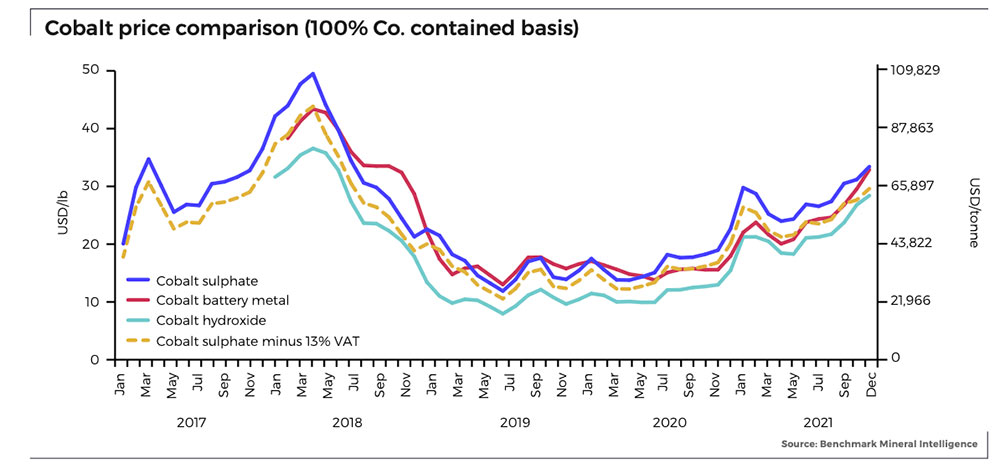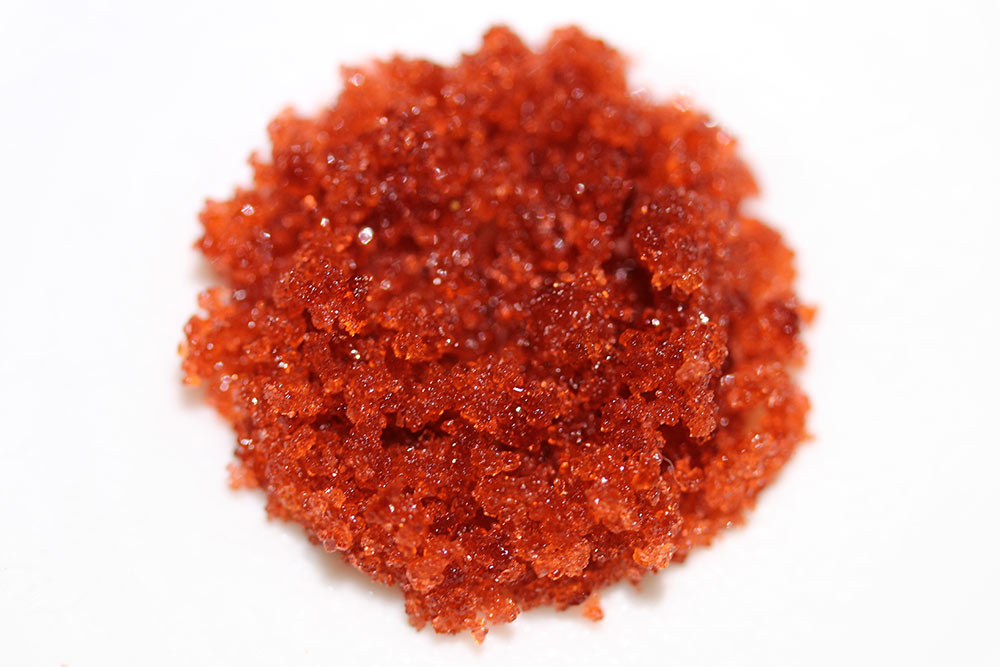Global cobalt production needs to double in just 8 years. Where is it coming from?

Pic: Getty
Cobalt prices performed strongly in the second half of 2021, rising for 100 consecutive days to hit more than US$70,000/t in December.
In 2022, Benchmark Mineral Intelligence projects the demand for cobalt out of the global battery sector alone will grow by more than 20% year on year — a significant step up in demand.
Meanwhile, forecasted supply side additions will struggle to keep pace with such growth, providing further support to prices.
Over the medium term, this small market – global production was just ~140,000t cobalt metal total in 2021 — will grow at an average compound annual growth rate (CAGR) of between 8-10% to 2030.
(Of that 140,000t, ~55% is currently consumed by the battery sector.)
Based on a CAGR of 10%, cobalt will be a +310,000tpa market by the end of the decade.
100% growth in just 8 years. Huge.
By 2050, Glencore has previously estimated about 507,000 tonnes per annum will be consumed – a ~300% increase on existing levels.

That’s because EV makers, a relatively small percentage of current demand, will need a lot more going forward.
German behemoth VW, for example, has formed a joint venture to produce cathode material at an as-yet undisclosed location in Europe.
The deal outlined targets to produce sufficient cathode material for 20GWh of cell production by 2025, scaling up to 160GWh by the end of the decade.
According to Benchmark Mineral Intelligence data, that 160GWh will require more than 20,000tpa of cobalt.
US based General Motors (GM) also announced in December that it had formed a JV with South Korean cathode producer, POSCO Chemical (POSCO), with plans to build a new high-nickel cathode material production base in North America.
Getting massive leverage to the cobalt thematic
Most cobalt comes as a byproduct of nickel or copper production. Not Cobalt Blue (ASX:COB), which is the only pure play cobalt producer in the listed world, says chief exec Joe Kaderavek.
COB is making big process on the flagship 81,000t Broken Hill Cobalt Project (BHCP) – Australia’s largest cobalt sulphide deposit — which could be in production by mid to late 2025.
Pre-production capex is estimated at ~$560m. The BHCP would produce +3,500tpa cobalt metal eq over a 20 years at a very low all-in sustaining cost of $US12/lb – making it profitable even at record low prices.
The cobalt price recently hit $33/lb. The leverage for COB is astonishing, Kaderavek told Stockhead.
“A US$2.50/lb increase in the price of cobalt delivers a 28% NPV (Post Tax) increase,” he says.
“For example, a mark to market exercise reveals that today’s Broken Hill project is worth $1.3Bn – as opposed to the $550m that was assumed on long dated numbers back in 2020.”
In 2022, COB is planning to operate its demonstration plant — a smaller version of the real thing — and deliver large scale samples to potential offtake partners.
Project approvals and a BFS will be finalised by the end of the year, ready for a final investment decision on the project by Q1 2023.
Despite additional DRC supply coming online soon, Kaderavek says over the long-term, supply will struggle to keep up with demand.
“There are over 50 such large facilities planned for the US and EU alone over the next decade.”
Kaderavek says battery makers and carmakers will need to move up the supply chain to make deals with raw material suppliers.
COB already has commercial partnerships with LG International, Mitsubishi Corporation & the giant Japanese trading house, Sojitz Corporation.
“Looking back over the course of 2021, our commercial discussions revealed three broad themes,” he says.
“One — Customers are looking to fill larger (typically “giga factory” quantities) orders for cobalt products – battery makers are therefore prioritising larger scale offtake. You need at least 10,000tpa of cobalt sulphate equivalent to get their attention at the moment.
“Two — customers now seek to engage in longer duration offtake to support EV production runs, typically up to 7–8-year duration.
“And three — non-African sustainably sourced cobalt is becoming a premium material as EV makers react to their consumer and legislative requirements and seek to influence upstream sourcing.”

Carmakers willing to pay premium for non-DRC cobalt
The question isn’t solely whether supply will be able to meet demand. Automakers, especially western automakers, are increasing putting ESG at the centre of everything they do.
That puts dominant global cobalt producer, Democratic Republic of Congo (DRC) under the microscope.
The landlocked African nation is a global giant when it comes to cobalt production.
According to the United States Geological Survey (USGS), the DRC produced 95,000 tonnes of cobalt in 2020, accounting for 68% of global output.
It’s where China – the world’s biggest consumer by far — gets ~90% of its supply.
But some high-profile supply agreements have shown that European consumers are committed to diversifying away from these problematic Chinese and DRC supply chains.
This underscores the importance of cobalt projects in ‘de-risked’ tier 1 jurisdictions – like those owned by COB, as well as Jervois Mining (ASX:JRV), Australian Mines (ASX:AUZ), Sunrise Energy Metals (ASX:SRL), Queensland Pacific Metals (ASX:QPM), red hot IPO Kuniko (ASX:KNI) and Metals X’s (ASX:MLX) nickel-cobalt spin-out Nico Resources (ASX:NC1) — just to name a few.
The pivot away from African cobalt towards more sustainable sourcing is another reason supply will struggle to keep up with demand, Kaderavek says.
“We are seeing a strong commercial pivot towards ethical sourcing of battery materials from the EU and US,” he says.
“At the same time the EU, Korean, Indian, Japanese and US governments are working with the Australian government to build a new critical minerals (rare earths and battery minerals) industry/supply chain.
“The recent creation of the Australian Government $1.6Bn Critical Minerals Loan Facility will soon be exceeded by low-cost government funds from these other jurisdictions.
“National security/strategic interests will therefore provide development incentives well beyond the current market forces – it’s a very exciting time!”
Cobalt stocks share price charts
Should cobalt investors worry about LFP batteries?
In 2021, Tesla spooked the market when it announced plans to adopt lithium iron phosphate chemistry (LFP) batteries for its high volume, standard range Model 3 and Model Y electric cars.
LFP does not use nickel and cobalt, which makes them much cheaper to produce. On the downside, they are far less energy dense than nickel-cobalt chemistries.
Kaderavek says COB considers it unlikely that LFP will be able to make substantial inroads into the battery market outside China.
“LFP’s specific energy density (Wh/kg) is ~30% lower as compared to the current (LG) NCM 721 cell,” he says.
“However, with the shift to next generation NCM 811 that gap widens to ~45%.
“In the long term, higher energy density is needed to lower costs, increase range and deliver lighter / smaller battery systems.
“LFP lacks a clear technology path to achieve higher energy density, and this will limit market share potential to shorter range entry level/ mass market vehicles.”
Related Topics
UNLOCK INSIGHTS
Discover the untold stories of emerging ASX stocks.
Daily news and expert analysis, it's free to subscribe.
By proceeding, you confirm you understand that we handle personal information in accordance with our Privacy Policy.








